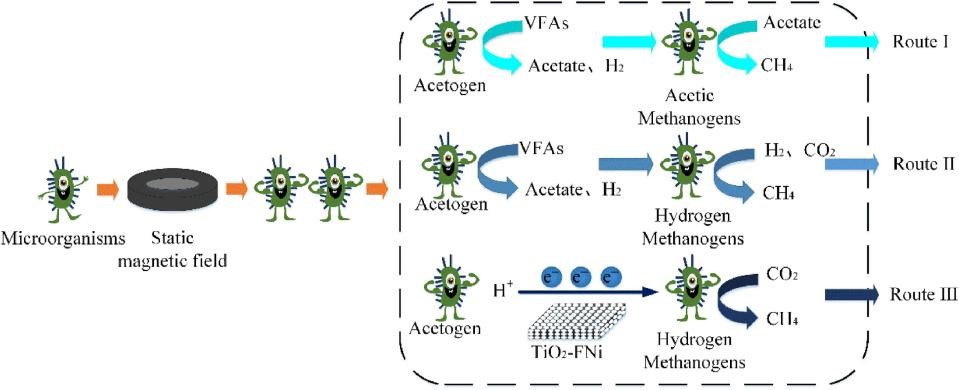Magnetic Field Enhances Generation of Synthetic Biogas
Date:20-09-2022 | 【Print】 【close】
The development and utilization of rural biomass energy is an important strategy to reduce the use of fossil fuels and resulting carbon emissions.
Agricultural waste such as straw and livestock manure contain a lot of carbohydrates such as glucose, starch, cellulose, etc., which can be used as nutrient sources for bacteria and promote the production of biogas.
Now, a joint research team led by Dr. ZHANG Yanhui from the Shenzhen Institute of Advanced Technology (SIAT) of the Chinese Academy of Sciences (CAS) has found that a magnetic field can help enhance the generation of synthetic biogas.
The study was published in Energy. Prof. ZHAO Bo from Northeast Electric Power University and Prof. YANG Yuyi from the Wuhan Botanical Garden of CAS were also involved in the study.
The researchers investigated the effects of using a static magnetic field (SMF) in the presence of the additive titanium dioxide-foamed nickel (TiO2-FNi) with bioaffinity during the anaerobic digestion and methanation of corn stover. In this process, TiO2-FNi is deposited on the bottom of the reactor in bulk form and the external magnetic field environment is provided by permanent magnets.
The additive TiO2-FNi used in this study is a porous conductive material. Its porous structure and multi-grooved surface, along with the non-biotoxicity of TiO2, increase its suitability for the adhesion of flora and the formation of electroactive biofilms that promote electron transfer.
The intensity of the magnetic field is regulated by controlling the distance between the permanent magnet and the bottom of the reactor. The cooperation with the magnetic field further promotes the rate of cell proliferation and glycolysis.
With the recovery rate of TiO2-FNi composite material reaching 99.29%, the process showed good recovery potential and environmental friendliness. The energy balance analysis also showed that the anaerobic fermentation process in the experimental group was 43.68%, which was 13.20 percentage points higher than the control group.
The experimental results showed that methane production increased 44.71% at a 2.82 g L-1 TiO2-FNi concentration and with a 11.4mT magnetic field. "By strengthening the methane production path of direct interspecies electron transfer, the recycling of CO2 is realized and the carbon emission in the reaction process is reduced," said Dr. ZHANG.
This study provides an environmentally friendly and sustainable strategy for the large-scale production of methane and hydrogen from agricultural waste.

Figure 1. Research method and result. (Image by Dr. ZHANG Yanhui)

Figure 2. Magnetic field enhances anaerobic digestion in methane production. (Image by ZHANG Yanhui)
Media Contact:
ZHANG Xiaomin
Email:xm.zhang@siat.ac.cn